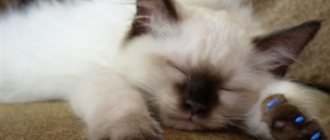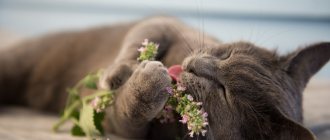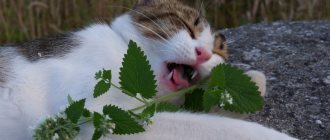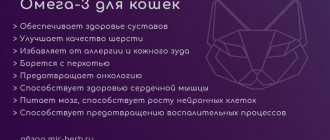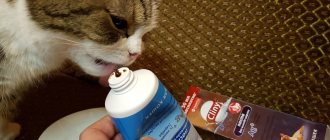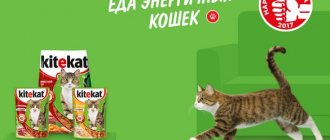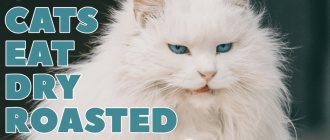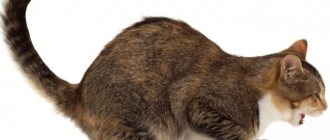Cats are clean animals that carefully care for their fur. Every day they lick the fur with their tongue, as a result of which some hairs enter the gastrointestinal tract, which is very unsafe for the cat. Wool clogs the intestines, causing abdominal pain, problems with digestion and stool. This can lead to the development of pancreatitis, gastritis and other gastrointestinal diseases.
Various methods are used to effectively remove hair from the stomach. Many veterinarians recommend using special malt pastes for this purpose.
In the article we will look at what malt paste is for removing hair from cats, the principle of action of the drug, how to use it correctly, contraindications, a review of popular pastes for hair removal, what other means will help cope with the problem
The Danger of Hairballs in a Cat's Stomach
Trichobezoars are the scientific name for hairballs that form inside a pet’s stomach or intestines. Their appearance is considered a natural process that occurs as a result of frequent washing.
Symptoms of blockage
The structure of the barbel tongue is similar to a grater due to the bristles on the surface. Because of this, hairs collect on the tongue, some of which the pet spits out. The hairs remaining in the mouth descend down the esophagus into the stomach. There they linger and gradually begin to accumulate, forming a dense clot.
Normally, it should be eliminated naturally during a bowel movement, but sometimes the trichobezoar causes a blockage. This is a health hazard that can lead to serious illnesses. Symptoms of blockage:
- lack of appetite;
- lethargic state;
- heat;
- cough with regurgitation of hairs;
- excessive salivation;
- constipation;
- constant vomiting;
- bloated stomach;
- pain when feeling the abdomen.
Difficulties with breeding trichobezoars accompany the lives of not only long-haired cats. Short-coated felines are also susceptible to developing hair clots inside the stomach. However, due to natural features, this process occurs slowly in them, which means the risk of complications in the form of blockage is significantly reduced.
Constant vomiting
One of the symptoms of a hairball is constant vomiting. As a result of frequent gastric emptying, the cat is deprived of a large number of useful elements necessary for its normal functioning.
The mustache is rapidly losing weight and may become dangerously dehydrated. If you do not take measures to eliminate the problem, the health and even the life of your pet will be at risk.
What are trichobezoars
This is the scientific term for hairballs that lodge directly in the stomach. Their formation due to regular washing and regurgitation is a natural process for representatives of the cat family. In most cases, the formation of hairballs and their removal does not cause noticeable problems, but in long-haired cats negative consequences are much more common.
Due to the narrow lumen of the esophagus, trichobezoars take on a cylindrical shape. Inexperienced owners are often scared when their cat begins to vomit due to their breeding, but there is no need to panic.
In its structure, a cat's tongue resembles a grater - its rough surface combs the fur when washing, and collects hairs. Some of them are spat out by the pet, others go down the esophagus, lingering in the stomach or going into the intestines, from where they are released with feces.
Note! If your pet has short hair, this does not prevent the formation of lumps and fur in the stomach. The process is slower and the risk of complications is reduced, but the likelihood of trichobezoars remains, so owners should be aware of the symptoms of this phenomenon and methods for eliminating them.
Normally this occurs without complications, but if the formation in the stomach becomes too large, it cannot leave the body. This often happens in the case of:
- intensive licking during molting;
- metabolic disorders;
- hormonal imbalances;
- stress;
- lack of vitamins;
- as a result of impaired motility of the gastrointestinal tract.
The animals themselves have already developed a mechanism to eliminate the problem - eating grass. Wheatgrass helps to regurgitate accumulated hair, however, this is only possible if the cat is outside. The likelihood of developing trichobezoars is especially high in Maine Coons, Persian cats and other breeds with long hair.
Symptoms of Hairballs in Cats
The problem of hairballs forming in the stomach can even occur in kittens. Normally, every pet cleans its digestive tract by regurgitating fur from one to six times a month.
If this process does not occur naturally, the following symptoms may appear:
- constipation, too hard stool with pieces of six in the stool;
- regular vomiting with hair coming out;
- heat;
- the appearance of blood or mucus in the vomit;
- cough;
- refusal to eat due to a feeling of pressure in the intestines and stomach;
- copious amounts of saliva;
- swollen belly - the cat does not allow you to touch it because of the pain.
If your pet has several of the symptoms on the list and you clearly see fur in the stool or vomit, be sure to visit a veterinarian. Usually, to relieve symptoms, malt pastes are prescribed, which facilitate hair removal in cats with long hair and pets prone to the formation of hairballs.
What is malt paste
It is better to purchase the product in specialized pharmacies or pet stores. Before use, it is important to read the instructions and pay attention to the expiration date. Expired paste can cause significant harm to health.
Compound
This is a paste-like substance interspersed with small solid particles. For ease of use, it is packaged in tubes made of polymers or metal.
Malt paste for hair removal for cats usually includes:
- malt extract;
- animal fats;
- vegetable oils;
- cellulose;
- vitamins, micro- and macroelements;
- yeast;
- bran;
- thickeners
To give an attractive taste and aroma, safe flavoring and aroma additives are used. Thanks to them, the mustache can enjoy the contents of the tube without much persuasion, and even with pleasure. Many pets perceive pasta as a valuable treat.
To maintain good condition of the skin and coat, the composition of malt paste for cats is enriched with Omega-3 and Omega-6 fatty acids, which are important for health. In addition, dietary supplements are introduced to normalize intestinal function.
Operating principle
Using malt paste to remove hair from a cat's stomach helps soften the hairballs that have formed. They are gradually removed from the pet's body during bowel movements. This effect is provided by the components contained in the product.
The operating principle can be described by the following diagram:
- A pasty substance envelops the clot and helps push it further along the gastrointestinal tract.
- The lump passes unhindered through the intestines, normalizing its functioning and freeing the body from hair accumulations.
As a result, the pet’s unpleasant symptoms disappear: nausea, vomiting, constipation. The substances included in the composition help normalize the microflora and restore the natural ratio of bacteria inside the furry body. This has a positive effect not only on the functioning of internal organs, but also improves the appearance of the pet.
Composition and principle of action of the paste
The main components of modern hair removal products are vegetable oils and fats, fiber, microcrystalline cellulose, dairy products, malt concentrate and ballast substances.
Some formulas have added TGOS - transgalactoolisocharides, which stimulate digestive activity and normalize the microflora of the large intestine. Recipes for combined products contain vitamins, absorbents and disinfectants, minerals and amino acids.
Operating principle of malt pastes
Hair removal products do not dissolve hairballs, but help remove them from the animal’s body.
Their second function is preventive. Pastes do not allow hairs that have entered the cat’s stomach to form large bezoars and grow into the intestinal walls.
How does this happen?
The malt and oils included in the formula of paste preparations envelop hairballs stuck in the animal’s gastrointestinal tract - this makes it easier to remove them out.
Wool is excreted from the cat's body with feces in an undigested and undigested form. In addition, the paste lubricates the intestinal walls, facilitating bowel movements.
Fiber and vegetable fats stimulate peristalsis of the intestinal wall - this normalizes stool and prevents constipation. Activating the intestines has a beneficial effect on the pet’s well-being, improves appetite, and prevents vomiting.
Pastes enriched with micro- and macroelements have a healing effect on the cat’s body:
- increase immunity;
- normalize the functioning of the liver and kidneys;
- improve wool quality;
- replenish reserves of micro- and macroelements.
Pros and cons of malt pastes
Advantages:
- Pleasant taste. Animals willingly eat the medicine.
- Effectively relieve constipation.
- There are no contraindications based on the age or condition of the animal.
- Compatible with other medications.
- Easy to dose.
- Do not cause addiction or allergies.
- Convenient to give along with food.
- The therapeutic effect is noticeable immediately.
The disadvantages of the product include the need for storage in the refrigerator and a long course of administration.
Important!
The formula does not contain addictive components, the active substances do not accumulate in the pet’s body - the drug can be used for a long period.
Are there any harms, contraindications and side effects?
The medicine for removing trichobezoars has no contraindications. Malt paste is given to kittens, adult cats, old and weakened pets. There are no restrictions on the breed of mustaches.
The paste has virtually no side effects. The components included in the composition sometimes lead to the development of allergic reactions, but do not cause poisoning or other negative reactions of the body. Therefore, long-term use of the drug is permissible, subject to strict adherence to the prescribed dosage.
Excessive amounts of the substance can cause redness of the skin and itching. Giving it in excess of the dosage is also not advisable because of the components with a laxative effect.
The medicine is not prescribed if the pet has a large hairball and intestinal obstruction is diagnosed. In this case, the problem will have to be solved with more radical measures - most likely, the cat will need surgery.
Cliny
Russian analogue from the company, characterized by an affordable price. The active ingredients are malt extract and whole milk powder. Not recommended for use in the presence of gastrointestinal diseases and allergies to cereals.
Ingredients: malt concentrate, refined corn oil, wheat bran, lactose monohydrate, soy protein isolate, whole milk powder, potassium sorbate, silver benzoate, water.
Price:
- small tube – 330 rub. / 30 ml;
- medium tube – 470 rub. / 75 ml;
- large package – 600 rub. / 200 ml.
Sanal
Another drug from the Netherlands. Sanal malt paste has no contraindications for use; it contains ash and vitamin E as additional components.
Ingredients: vegetable products, oils and fats, sugar; supplements per 1 kg: vitamin E 75 mg.
Price: 190 rub. / 20 ml and 550 rub. / 130 ml.
All of the products mentioned effectively eliminate trichobezoars, but before purchasing you should carefully read the instructions for any contraindications.
Advice! The mixture has a thick consistency, so squeezing it out of the tube may be difficult. To avoid this, you can remove the tube from the refrigerator shortly before use and leave it to warm up to room temperature.
When does a cat need hair removal paste?
It is not so difficult for an attentive owner to notice problems with a pet’s digestion. Symptoms caused by trichobezoar formation include regular nausea and vomiting. Sometimes your pet has problems defecating.
In addition, tufts of hair are visible in vomit and feces. The animal begins to show anxiety and refuse to eat. This behavior is especially typical during seasonal molting, when the fluffy loses a significant part of its fur.
The use of a paste-like preparation or its analogues can help a suffering mustache or prevent the occurrence of a problem.
Reviews from veterinarians
global $ads_google;
//data-ad-slot=”2475549904″ $ads_google = empty($ads_google) ? false : true; ?> if ($ads_google == false) {?> $ads_google = true; ?> } ?> The opinion of veterinarians should not be neglected, and they, unlike manufacturers who have direct benefits from the regular purchase of hair removal paste, only care about the health of pussies. Doctors believe that you should not interfere excessively with the functioning of the cat’s body, and you can help it during the molting period or with regular vomiting of hair.
Abuse will not be beneficial, because the product is quite fatty, which in itself is not very good for regular consumption. In addition, fats can affect the functioning of the pancreas and liver.
If you constantly interfere with the functioning of the gastrointestinal tract in this way, it can disrupt it, weakening natural motility.
For chronic gastrointestinal diseases, you should first visit a veterinarian and not buy a product without receiving a specialist’s recommendation.
Application and storage
Using the drug is very simple, especially since instructions for using malt paste for cats are included with each package. Veterinarians recommend giving it for treatment and prevention purposes.
To prevent intestinal blockage, the drug is used for one week once a month. Give no more than 3 cm of the substance per day. During seasonal molting and for medicinal purposes - 5 cm. This portion is given until the end of severe hair loss. The paste is squeezed onto your hand, onto a plate, or given directly from the tube.
The medicinal substance has a pleasant smell for moustached fussy animals, so they perceive it as a delicacy. If the pet begins to be mischievous and refuses to take it, then the required amount is mixed with a small amount of food.
Give a paste-like substance 1-1.5 hours before or after meals. It is important to ensure constant access to drinking water.
The sealed tube with the drug is stored at a temperature of 5 to 25˚C. If the product has already been used, keep the tightly closed package in the refrigerator. Thanks to this, the fatty substances in the composition do not oxidize and remain safe for the pet’s health. A closed tube of the substance can be stored in the refrigerator for 24 months.
It is necessary to ensure that the fluffy does not have access to the packaging. Attracted by the pleasant aroma and taste, the animal is able to gnaw and eat the contents. This will significantly exceed the daily norm and act like a laxative.
Main reasons for eating wool as food
Unfortunately, at the moment there are no exact reasons to explain this behavior in animals. Some of the assumptions and guesses include various psychological disorders or a lack of nutrients and vitamins in the pet’s daily diet. Many owners note that after severe stressful situations, their cat changed its preferences and tastes in food. If you begin to notice how your beloved cat often swallows hair while washing and cannot get rid of it on its own, and also shows a special interest in woolen products as food, then you should contact a specialist as soon as possible. The veterinary pharmacy and pet store Gomeovet will provide advice, help identify the reasons for this behavior and make your pet’s life easier.
Popular brands
There are several versions of the drug available in pet pharmacies and specialty stores. Which one to choose is up to the owner and his mustachioed friend to decide.
Cliny
These are products of a domestic company, which are popular due to their low price and good quality. The drug effectively removes trichobezoars, relieving vomiting and constipation. Additionally, the product is enriched with silver ions to improve the general condition of the pet. The pleasant smell attracts the mustache. The average cost is 250-280 rubles per 45 g.
Gimpet
A German analogue of the drug, which contains natural malt and vegetable oil. The pleasant structure and pronounced aroma are very popular with pets. There is no sugar or other flavor enhancers among the ingredients. Price – 700-800 rubles per 200 g.
Beaphar
An analogue enriched with Omega-3 and Omega-6 acids that are beneficial for the health and appearance of your furry friend. Contains fermented milk products and sunflower oil. The products help get rid of hair clumps and harmful bacteria. The manufacturer added caramel for an attractive taste. Cost – 500 rubles per 100 g.
Sanal
A popular brand among mustache owners, it has a pleasant meat aroma. It contains vitamin E and additives that improve your pet's appetite. This effective remedy has an excellent preventive effect. The cost of the product is 170 rubles for 20 g.
Gimcat
Paste for removing trichobezoars, which does not contain sugar or harmful preservatives. There are different flavor options. According to the instructions, the daily amount of paste is 1 cm more than other brands. Average price – 610 rubles per 100 g.
The dangers of excessive cat licking
Filling the stomach with hair pellets can cause blockage of the intestinal lumen.
However, filling the stomach with hair pellets is fraught with some difficulties:
- internal fullness does not allow the pet to get enough, resulting in exhaustion;
- a large amount of hair inside can cause blockage of the intestinal lumen;
- the remaining hairs behind the fangs gradually grow into the gums, causing inflammation.
The question arises how to protect your pet from the formation of hairballs in the stomach cavity. Unfortunately, a person is powerless against this, but you can help the lumps come out. There are several ways to get this help. First you need to figure out how to understand that a cat needs help.
Analogs of hair removal pastes
Malt paste against hairballs for cats is an effective and convenient remedy. However, some cats refuse pasty treats, preferring other forms of release.
Treats
A pasty substance similar to marshmallow is produced in the form of compressed pads or rings. Pets really like these products because, in addition to the classic ingredients, they contain catnip.
Tablets and vitamins
Special nutritional supplements help cope with trichobezoars. They are called phytomins and are produced from extracts of medicinal plants, minerals, lecithin and taurine. Phytomines are produced in the form of tablets that are convenient to give to your pet during meals.
The veterinarian prescribes the tablets, determining the dosage and duration of their use. The effect of phytomins is not quick - the hair will leave the cat’s body gradually.
In addition, there are special vitamin and mineral supplements designed to gently cleanse the gastrointestinal tract. Pet Naturals of Vermont products, containing plantain extract and healthy fatty acids, are popular among cat owners.
Some dry food manufacturers immediately include phytomins and malt extract in their dry granules. Usually in such cases a mark is placed on the packaging about the hair-removing properties of the food. If the cat eats just such a product, there is no need to give additional malt pastes and analogues.
Will regular grass do the job?
Animals themselves have long developed a mechanism for removing lumps from the stomach and intestines. They eat grass - usually wheatgrass. It can trigger a gag reflex and thereby help regurgitate accumulated hair.
Street animals easily use this, but mustachioed couch potatoes do not have this opportunity. Then pots with sown grass and sprouted sprouts come to the rescue, which are added to the cat’s food.
For short-haired cats, grass is enough, but long-haired cats will need paste in any case. Veterinarians also recommend malt products for animals with sensitive digestion and chronic diseases.
Reviews from consumers and veterinarians
Albina: “I have a Scottish fold. One day the cat started coughing and vomited a hairball. I called my veterinarian, he recommended purchasing Gimpet or Beafar hair removal medications. The pet store only had Klini, a Russian drug. The taste of the food additive immediately attracted the cat’s attention, and she licked it off my hand. The nausea stopped. Now I give her the paste every morning before breakfast.”
Sergey: “When I took my Persian to the nursery, I was immediately advised to buy hair removal paste for cats. The cat is long-haired and sheds heavily. I purchased the product “8 in 1 Excel” - it does its job perfectly. The cat has regular stools; hairballs are removed into the litter box. There is no vomiting or regurgitation. The cat has an excellent appetite. The wool is in perfect order.”
Arkady, veterinarian: “Malt pastes can hardly be called a medicine. This is a feed additive that can be taken on an ongoing basis without any harm to the pet’s health. The advantage of these drugs is that manufacturers add vitamins and minerals to them. Clients often come to me with the question: “Is it necessary to comb the cat if we give it malt paste?” Of course it is necessary. Scratching and bathing – no one can cancel these mandatory procedures. It is also important to promptly clean the cat’s bedding and habitat from accumulated hair.”
Svetlana Igorevna, veterinarian: “As an alternative to malt paste, I would recommend grass for cats. Some owners give their pets regular Vaseline from the pharmacy, but I still recommend not getting carried away with this, but buying specialized products. Veterinary pharmacies now have a good selection of drugs, both imported and domestically produced. The active ingredients of most of them are identical. You can choose malt paste according to your wallet. There are products with good formulas enhanced with vitamins, amino acids and minerals.”
Video
What are the contraindications?
Manufacturers do not indicate contraindications as such in the instructions. Malt paste is prescribed even to old individuals, very young kittens and pregnant cats.
Still, malt paste should be given with caution to animals that have problems with the liver and pancreas . This is due to the high content of fatty components in the composition.
It is also not recommended to give malt paste systematically, but only when necessary . Since systematic stimulation of the gastrointestinal tract worsens the quality of work of the animal’s digestive organs. If there are systematic problems with peristalsis , then this is a reason to contact a veterinarian for an examination, and not self-medicate.
Animals with gastrointestinal dysfunction may experience vomiting and diarrhea .
Some pastes contain preservatives and flavorings that can cause allergies in the animal. To avoid an acute allergic reaction, it is recommended to give half the dose of the drug and observe the body’s reaction.
Despite the fact that malt paste can be combined with other medications, it is not recommended to use it simultaneously with laxatives .

